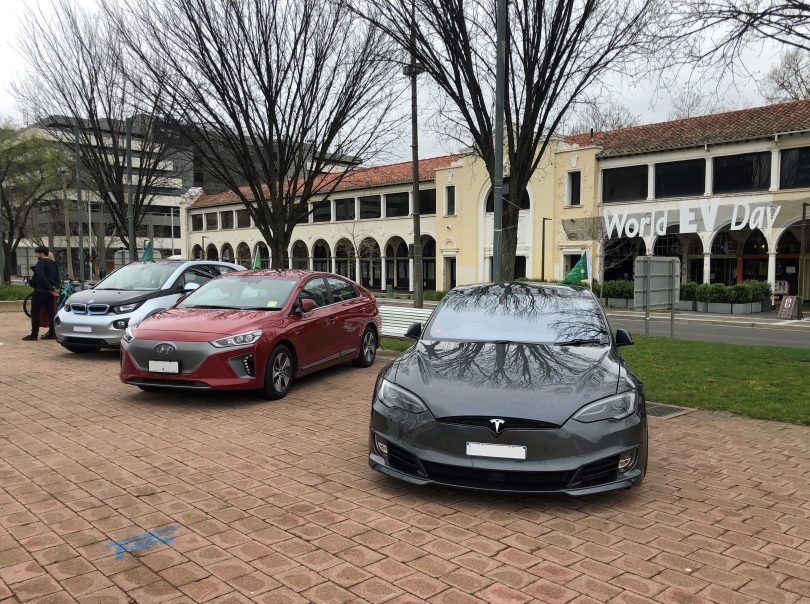
Electric vehicles at the World EV Day event in Canberra in September 2020. Photo: James Coleman.
With the ACT Government announcing two years’ free registration for new and used electric vehicles acquired after 24 May, in addition to new EVs being exempt from stamp duty, there’s never been a better time to think about ditching your petrol or diesel drive.
And that’s before governments really get to work with additional taxes on fossil-fuelled vehicles.
Combined, the incentives take about five percent off the cost of an EV, so here are some new models you should look at and what you can now expect to pay for them (approximately).

Every electric car seems to have blue on it somewhere. Photo: MG Cars UK.
MG ZS EV ($41,790)
ACT Minister for Energy and Emissions Reduction Shane Rattenbury recently bought an MG ZS EV, the cheapest new electric vehicle currently sold in Australia. On top of the standard warranty and roadside assistance, MG also includes an eight-year, 160,000 km “battery warranty”, fast becoming a must-have with electric cars.
As with range in a car with an internal combustion engine, it depends entirely on what you do with it, but MG estimates an average of 263 km. An 80 per cent charge can be achieved in about 45 minutes on a fast charger or a full charge in seven hours through a standard socket at home.

An EV towing a caravan? It can be done. Photo: James Coleman
Hyundai IONIQ Electric ($49,284) and Kona Electric ($63,851)
Warranties and charging times for the South Korean sedan and SUV duo are comparable with the MG, but both offer more range – around 300 to 400 km.
Unlike the MG, Hyundai realised that electric cars don’t need a grille at the front, although the IONIQ does boast “active shutters”, which open and close depending on cooling requirements.

The Nissan Leaf. Photo by Rob Olgivie.
Nissan Leaf ($61,741)
It’s one of the longest-standing names on the EV scene but each new Leaf model seems to be more expensive than the last.
Fortunately, the Leaf is also proving popular with independent importers who ship examples from Japan for a lot less than the new price. IonDNA, a dealership in Fyshwick devoted to electric vehicles, has several Nissan Leafs on sale from about $20,000, in near factory-new condition.

Sonja Skagen, the proud owner of a Jaguar I-Pace, Jaguar’s first all-electric performance SUV. Photo: Michelle Kroll.
Jaguar I-Pace ($134,690+)
Sonja Skagen says she loves the feeling of all-wheel drive and her husband already had a Jaguar F-Type sports car, so when her Subaru Forester became a casualty of Canberra’s hail storm, she upgraded to the I-Pace, Jaguar’s first all-electric car. She says it gets her to the coast and back with no trouble, and it’s scarily quick: 0-100 km/h takes just 4.8 seconds.

The Model 3, the entry-level ticket into the Tesla range. Photo: James Coleman.
Tesla Model 3 ($62,990+), Model S ($132,718+), and Model X ($157,418+)
Elon Musk and his Californian upstart was the manufacturer that made the other car companies sit up and take EVs seriously. Tesla showed the world an electric car means instant torque, head-snapping acceleration and even Fart mode (Google it … you’ve been warned).

Mercedes-Benz EQC. Photo: Daimler Media.
Mercedes-Benz EQC ($141,400+)
By and large, electric cars are still made of the same stuff as every other car before them, but with EQC, Mercedes says they have gone a step further and used renewable raw materials such as hemp, kenaf, wool, cotton, paper and natural rubber in 99 of the EQC’s components. Included in the price is also a five-year subscription to Chargefox, Australia’s largest network of charging stations.

No, you can’t just pull it out as a prank. Photo: Audi Australia
Audi e-tron ($148,100+)
The e-tron is much like Audi’s gazillion other SUVs. It’s beautifully sculptured and solid, but in case you missed the lower-case ‘e’ in the name, it’s electric. And – a one-up on Mercedes – the Audi comes with a six-year Chargefox subscription.

The Taycan, as specced by Queanbeyan’s own Mark Webber. Photo: Porsche Newsroom.
Porsche Taycan ($191,000+)
Until five minutes ago, Tesla was the coolest EV in the world. Then the Porsche Taycan arrived. The four-door Taycan is causing even die-hard petrolheads to give some ground to the EV movement, possibly helped by the fact it entered the Guinness World Records last year for “the longest drift in an electric vehicle”. Everybody is a little puzzled as to why there is a turbo version, though.
But wait, there’s more…
The internal combustion engine will be with us for some years yet, but the writing is definitely on the wall. With that in mind, every carmaker is turning their attention to electric or petrol-electric hybrids.
The Mazda MX-30, Volvo XC40 Recharge, Mercedes-Benz EQA, BMW iX and Tesla Model Y – to name a few – are either open to order now or will be very soon. The Honda-e, a funky little electric hatchback, is also on the cards for the IonDNA dealership.
The future is here, even if it still isn’t exactly cheap.





















